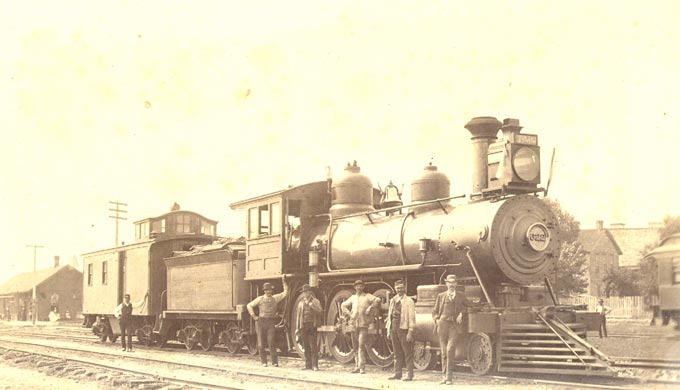The Hondo area has been “on the map” since 1689, when Spanish explorer Alonso De Leon passed through, naming the Medina River and the Hondo (“deep”) and Seco (“dry”) Creeks on his way to East Texas. In 1691, the first provincial governor of Texas, Domingo Teran de los Rios, blazed the trail for El Camino Real (“Royal Highway”), skirting the Apache and Comanche strongholds in the hills just to the north. from the time that San Antonio was founded in 1718, dozens of expeditions and hundreds of travelers passed through the Hondo area. The Republic of Texas fought the Mexican Army here in the 1842 Battle of the Arroyo Hondo.
 Wikipedia
Wikipedia
History
The History of Hondo

Photo: thetrain.com
But it was the building of the railroad in 1881 that brought “Hondo City” into existence almost 200 years after De Leon’s first expedition. When the Galveston, Harrisburg & San Antonio Railroad reached a promising spot 41 miles west of downtown San Antonio, the company platted a town and began selling lots. A post office was established the following year, but in 1884, there were still only 25 residents; a court case prevented further development until 1891.
But the floodgates were opened in 1891, and Hondo began a period of explosive growth. In 1892, when there were still just 200 people in Hondo, Medina County voters chose it as the new county seat (replacing Castroville, which is located near the eastern edge of the county). A county jail and an imposing courthouse with a distinctive clock tower were completed in 1893. The name of the town was shortened to Hondo in 1895, but the town itself expanded to become the major commercial center for most of Medina County. The downtown business district filled up with two-story buildings, most constructed with brick from D’Hanis (a few miles down the track). By 1915, the population had grown to 2,500.

Photo: edwardsaquifer.net
A dam across the Medina River formed a lake north of Hondo in 1913. With the increase of automobiles, highway construction began. Highway 3, which came through town on its way from Del Rio to San Antonio and Houston, wasn’t completed until 1922, but already the new mode of transportation had bred a new class of criminal. In January of 1921, the now-legendary “Newton Boys” gang arrived in Hondo to rob one of the two downtown banks.
“We drove nothing but Studebakers,” Joe Newton said later. “They was tough. You could just run them into anything. And the Goodyear tires would last 10,000 miles before they’d go to peeling off.” They cut the telephone wires, stole a crowbar from a construction site (it’s at the Medina County Museum now) and broke in through a barred window in the alley. The town was guarded by a night watchman, but it was a cold night, and he stayed in the warm railroad depot. The first bank took only a few minutes to rob, because the vault had been left open, so the Newton Boys decided to rob the other one, too. The second one took a little longer, since Willis Newton had to blow the door off the vault with nitroglycerin, but the watchman never had a clue. By the time the robberies were discovered, the Newtons, their Studebaker, and more than $30,000 were long gone.

Photo: Wikipedia
In 1930, the Hondo Lions Club put up a sign near the city limits, saying, “This is God’s Country. Don’t drive through it like Hell.” In deference to those who thought it unmannerly, they later added the word “please” to the second sentence. The sign became a famous Hondo landmark.
Hondo survived the depression, and began to boom once more with the outbreak of World War II. Hondo was incorporated as a city in 1942, and the Hondo Army Airfield (at one time, the largest air navigation school in the world) was built that same year on the northwest side of town. As many as 3,000 people were employed by the Zachry Company of San Antonio during air field construction, and more than 5,300 military personnel were stationed there by the end of the year. In all, more than 14,000 navigators were trained there by 1946. (The airfield then reverted to the city, and is now Hondo Municipal Airport.) In 1941, the distinctive tower was removed from the courthouse, and wings were added to the two sides of the building in 1942, during a renovation which also included the installation of indoor plumbing.

Photo: Wikipedia
Hondo continued to grow through the next several decades and was home to more than 200 businesses by 1980. The economy is based on agriculture, ranching, tourism and light industry (mainly plumbing fixtures and aircraft engine parts); Hondo remains the commercial center for the western half of Medina County. Hunting is a major pastime in Hondo’s surrounding countryside, and nearby Medina Lake provides an abundance of recreational opportunities. The 777 Exotic Game Ranch, near Hondo, is a favorite of hunters and fishermen and has been used as a set for several movies, including Jim Carrey’s 1995 movie, “Ace Ventura — When Nature Calls.” In Hondo itself, there is a golf course, a public swimming pool and (in a restored 1897 railroad depot) the Medina County Museum.
One of Hondo’s unique attractions is the “South Texas Maize,” a cornfield labyrinth open each fall on Highway 90, just east of town. For details on that and other community events, call the Hondo Chamber of Commerce at 830-426-3037, or visit www.hondochamber.com.

